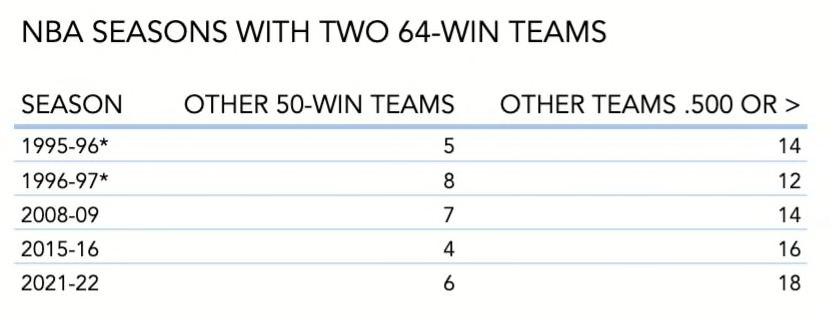The Whiteboard is The Step Back’s daily basketball newsletter, covering the NBA, WNBA and more. Subscribe here to get it delivered to you via email each morning.
When talking about the state of competitiveness in the NBA, the discussion generally revolves around two extremes — parity and elitism. Whether you’re talking about the entertainment product, the business end of things or simply an ideal version of professional sports, is better to have a structure where a handful of teams dominate as the only real contenders, or one where any team can beat any other on a given night, one in which the field of championship contenders is as wide open as possible?
Usually, these two structures are presented as diametrically opposed, mutually exclusive. But through the first quarter of the 2021-22 NBA season, they seem to be co-existing.
The Golden State Warriors (18-2) and the Phoenix Suns (17-3) have both gotten off to historic starts — the Suns with a 16-game win streak and the Warriors with an SRS (strength-of-schedule adjusted point differential) that is currently the best regular-season mark of all time. Their numbers are least partly warped by the fact that they haven’t played each other yet — something they’ll do twice this week — but they’re on track to become just the fifth pair of teams in the 3-point era to finish with a win percentage of .775 or better (a 64-win pace) in the same season.
In each of those previous cases — the Bulls and Sonics in 1995-96, the Bulls and Jazz in 1996-97, the Cavaliers and Lakers in 2008-09 and the Spurs and Warriors in 2015-16 — the dominance at the top led to a contraction of parity below them.

Besides the Warriors and Suns, 18 other teams are currently at .500 or better so far this season, a significant high for this sample even when you consider that there were only 29 teams in the league for the 1995-96 and 1996-97. The offshoot of that is historic dominance in the midst of tiered races that feel extremely wide-open.
With 20 teams at .500 or better, several others hovering close and the NBA’s new play-in structure, only a handful of teams are legitimately removed from playoff competition. And the two historically dominant teams are surprises to a large degree — 538’s prediction model gave them a combined chance of just 9.1 percent of winning the title before the season began. Even now, those combined odds have climbed to just 17 percent and the Bucks, Nets, Jazz and Nuggets are still sitting at 9.0 percent or better on their own.
What happens next for this NBA season?
Obviously, it’s unlikely that most team’s records settle in the exact place they are now, as entropy and progression to the mean duke it out over the next 60 or so games. Several preseason contenders (the Lakers and Bucks) are getting healthier and could be primed to shake off early-season rust. Several other surprisingly hot teams (the Wizards and Mavericks) have begun to fade a bit. The Warriors and Suns probably won’t stay quite as dominant as they’ve looked so far. And the looming shadow of injury has the potential to change the fortunes of any NBA team in a second.
But it’s worth pausing to look at this snapshot of the league as it stands right now, these two competing visions of what the NBA should be. Which end of the standings do you find more compelling — the lofty heights or the inflated middle? Assuming that what we’ve seen so far is a fluke and that they can not continue to coexist in previously unthinkable ways, which would you rather see become the dominant narrative for the rest of the season?
#OtherContent
With Jamal Murray still out and Michael Porter Jr. undergoing back surgery, are the Denver Nuggets watching their championship hopes slip away?
The Houston Rockets haven’t been able to trade John Wall and now he doesn’t want to sit out and wait anymore. Does this make things better or worse?
Shahd Abboud made history as the first-ever Arab-Israeli captain of a team in Israel’s Female Basketball Premier League. She’s using her platform to create more opportunities for women like her.